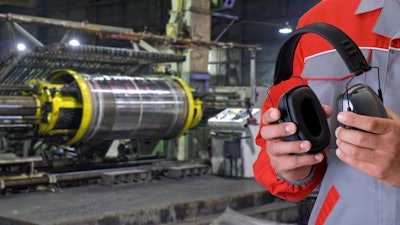
Every day, 22 million U.S. workers—roughly the entire population of Florida—are exposed to hazardous noise levels, putting them at risk of job-related hearing loss. Because of this widespread exposure, noise-related hearing loss affects one in every four adults, making it the third most common chronic health condition in the U.S.—more prevalent than diabetes or cancer.
While hearing loss itself may not be life threatening, it can put workers at significant risk of other work-related accidents and injuries. The inability to detect ambient sounds, warning alarms and voices means employees with hearing loss may not be able to avoid other hazards and accidents. Even worse, hearing loss can have a significant impact on employees’ quality of life. It can cause miscommunication and misunderstandings that strain personal relationships.
These personal struggles can have a direct impact on job performance, causing distraction and disengagement, reduced productivity, more sick days and a higher cost of providing healthcare. In fact, when these costs are combined with penalties and compensation claims for hearing loss disability, OSHA estimates that work-related hearing loss costs employers $242 million a year.
Fortunately, hearing loss is preventable, and manufacturers have a responsibility to protect their employees from hearing injury, just as they would any other workplace hazard. Here are seven simple and extremely economical solutions that can help.
- Adhere to the NIOSH Recommended Exposure Limit (REL). While these guidelines, which recommend keeping the noise level below 85 dBA over an eight-hour shift, may seem very restrictive, it’s not just the noise level that matters—the intensity, frequency, duration and proximity of sound also play a role in hearing loss. Adjusting the work environment, installing noise dampening systems, baffling on walls, or simply partitioning off the work site where possible can make a big impact on noise level exposure.
- Implement a hearing conservation program. These programs take a multi-pronged approach to preventing hearing loss that includes measuring/monitoring noise levels in the facility, providing free annual hearing exams and hearing protection, and evaluating the effectiveness of hearing protection used. At an estimated cost of just $350 per worker each year, this can be far less expensive than the economic burden of hearing loss, which can reach $300,000 per individual.
- Train employees in the correct use of hearing protection. You may already provide ear plugs or over-the-ear muffs for employees, but do employees know how to use them? For example, if foam earplugs aren’t inserted properly, they will not provide adequate protection. Offer onboarding and regular refresher training in correct usage.
- Monitor employees’ hearing. Work-related hearing loss works like a dimmer switch—it happens so gradually over time that employees may not realize it. Loved ones are usually the first to notice, and by then the damage can be severe. Providing regular hearing screening to employees can provide empirical evidence to document hearing loss, which can encourage proper use of hearing protection and nudge those who may be in denial to seek treatment.
- Make the hearing loss conversation a priority. There’s often stigma and shame around hearing loss. Some people hesitate to acknowledge they can’t hear because it makes them feel old or handicapped, and they may be embarrassed to admit they need hearing aids. Hearing works in a “use it or lose it” way. When the brain is deprived of auditory stimulation, over time it “forgets” how to hear as well as it once did. The longer you wait, hearing aids may not work as well. Companies can overcome some of the stigma by normalizing the conversation about hearing loss prevention and treatment with training, signage and one-on-one conversations.
- Partner with insurance and hearing aid companies. The cost of hearing aids is often the biggest barrier to access. Manufacturers can help overcome that by partnering with hearing aid providers to offer discounts on products and even hosting on-site evaluations. Make sure your insurance carrier offers coverage for hearing aids to help offset the cost for staff.
- Make employees aware of the options. Hearing aid technology has improved dramatically over the last 10-15 years. Many include innovative options like the ability to connect to audio devices, so they work like earbuds to stream music, podcasts, phone calls, etc. Some also come with app-based controls that allow for customized settings based on the environment, like a speech boost for going to the theater or background noise cancellation for going out to a bar with friends. They’re also much more durable, including sweat and dirt proof models for those with active lifestyles.
Hearing loss can be a devastating injury that takes a major toll on employees’ work and personal lives, and their overall health and safety. Manufacturers have an obligation to do whatever they can to minimize the risk of hearing loss, and to provide easy and affordable access to solutions.
Dr. Hope Lanter is the lead audiologist at Hear.com






















